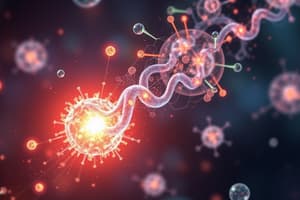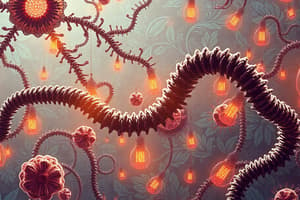Podcast
Questions and Answers
Which of the following processes requires energy for synthesis?
Which of the following processes requires energy for synthesis?
- Passive transport
- DNA replication (correct)
- Osmosis
- Cell division
What is one primary function of the sodium-potassium pump?
What is one primary function of the sodium-potassium pump?
- To maintain ion balance across membranes (correct)
- To synthesize proteins
- To generate ATP
- To transport water molecules
Which of the following is NOT a reason energy is needed in living organisms?
Which of the following is NOT a reason energy is needed in living organisms?
- Maintaining body temperature
- DNA replication
- Photosynthesis (correct)
- Mechanical work
What type of energy expenditure occurs during muscle contraction?
What type of energy expenditure occurs during muscle contraction?
Why is energy crucial for maintaining body temperature in organisms?
Why is energy crucial for maintaining body temperature in organisms?
What is the primary role of ATP in cellular processes?
What is the primary role of ATP in cellular processes?
Which route of ATP synthesis requires oxygen?
Which route of ATP synthesis requires oxygen?
What happens in chemiosmosis during ATP synthesis?
What happens in chemiosmosis during ATP synthesis?
What is the main purpose of glycolysis in respiration?
What is the main purpose of glycolysis in respiration?
Which of the following statements about ATP is incorrect?
Which of the following statements about ATP is incorrect?
Which of the following correctly describes the products of glycolysis?
Which of the following correctly describes the products of glycolysis?
What is the significance of the high turnover rate of ATP?
What is the significance of the high turnover rate of ATP?
What is the initial substance required for glycolysis?
What is the initial substance required for glycolysis?
How many ATP molecules are consumed in the first stage of glycolysis?
How many ATP molecules are consumed in the first stage of glycolysis?
Where does glycolysis take place within the cell?
Where does glycolysis take place within the cell?
What is the primary reason that ATP is considered the immediate source of energy in cells?
What is the primary reason that ATP is considered the immediate source of energy in cells?
Which of the following statements about ATP hydrolysis is correct?
Which of the following statements about ATP hydrolysis is correct?
What is the role of the phosphate group (Pi) in ATP synthesis?
What is the role of the phosphate group (Pi) in ATP synthesis?
What is one of the key features of ATP concerning its role in metabolism?
What is one of the key features of ATP concerning its role in metabolism?
How much energy is released during the hydrolysis of ADP to AMP?
How much energy is released during the hydrolysis of ADP to AMP?
What is a key process that occurs during the Link Reaction involving pyruvate?
What is a key process that occurs during the Link Reaction involving pyruvate?
What is produced as a result of the Link Reaction when 2 molecules of pyruvate are processed?
What is produced as a result of the Link Reaction when 2 molecules of pyruvate are processed?
Where does the Link Reaction occur within the mitochondrion?
Where does the Link Reaction occur within the mitochondrion?
What happens to pyruvate during the Link Reaction if oxygen is present?
What happens to pyruvate during the Link Reaction if oxygen is present?
Which of the following statements about the Link Reaction is true?
Which of the following statements about the Link Reaction is true?
What is Coenzyme A primarily used for in cellular respiration?
What is Coenzyme A primarily used for in cellular respiration?
Where do the reactions of the Krebs cycle primarily take place?
Where do the reactions of the Krebs cycle primarily take place?
Which of the following is a product formed during the Krebs cycle?
Which of the following is a product formed during the Krebs cycle?
What happens to Citrate in the Krebs cycle?
What happens to Citrate in the Krebs cycle?
What is the significance of having two pyruvate molecules formed in glycolysis for the Krebs cycle?
What is the significance of having two pyruvate molecules formed in glycolysis for the Krebs cycle?
What is the primary function of the electron transport chain (ETC) in oxidative phosphorylation?
What is the primary function of the electron transport chain (ETC) in oxidative phosphorylation?
Which molecule acts as the final electron acceptor in the electron transport chain?
Which molecule acts as the final electron acceptor in the electron transport chain?
What is formed when protons move through ATP synthase?
What is formed when protons move through ATP synthase?
What is created in the intermembrane space as a result of the movement of protons during electron transport?
What is created in the intermembrane space as a result of the movement of protons during electron transport?
Which of the following correctly describes the process of chemiosmosis in oxidative phosphorylation?
Which of the following correctly describes the process of chemiosmosis in oxidative phosphorylation?
Study Notes
Energy
- Energy is essential for multiple processes in living organisms, including anabolic reactions like protein synthesis and DNA replication.
- Active transport mechanisms, such as the sodium-potassium pump, rely on energy.
- Mechanical functions, including muscle contraction and movement via flagella or cilia, require energy.
- Organisms use energy to maintain homeostasis, support bioluminescence, and transmit nerve impulses.
ATP as Energy Currency
- ATP (adenosine triphosphate) hydrolysis releases energy through the conversion to ADP (adenosine diphosphate) and AMP (adenosine monophosphate).
- Energy release from ATP hydrolysis is characterized by the values: 30.6 kJ mol⁻¹ for ATP to ADP, 30.6 kJ mol⁻¹ for ADP to AMP, and 14.2 kJ mol⁻¹ for AMP to adenosine.
- ATP is small, water-soluble, and easily transported within cells, making it an immediate energy source.
- Phosphate (Pi) is an effective leaving group, allowing ATP synthesis via ATP synthase to be reversible and efficient.
- ATP maintains a high turnover rate and acts as a link between anabolic (energy-consuming) and catabolic (energy-releasing) reactions.
ATP Synthesis
- ATP can be synthesized through glycolysis and the Krebs cycle, with oxidative phosphorylation occurring during aerobic respiration.
- Only oxidative phosphorylation necessitates oxygen, which combines with electrons and protons in the final electron acceptor stage of respiration.
- Absence of the electron transport chain (ETC) prevents chemiosmosis and ATP synthesis.
Respiration Overview
- Respiration processes utilize organic molecules as fuel, proceeding through glycolysis, link reaction, Krebs cycle, and oxidative phosphorylation.
Glycolysis
- Glycolysis breaks down glucose to form two molecules of pyruvate and occurs in the cytoplasm.
- The initial step involves the phosphorylation of glucose using 2 ATP to provide activation energy.
- The phosphorylation process involves conversions from glucose to glucose phosphate, then to fructose phosphate, and ultimately onto fructose bisphosphate.
Link Reaction
- Takes place in the mitochondrion matrix, requiring active transport of pyruvate into the matrix.
- Decarboxylation removes CO₂, and dehydrogenation removes hydrogen.
- Generates a net gain of 2 ATP and 2 reduced NAD from 2 pyruvate molecules.
Coenzyme A
- Coenzyme A, composed of a nucleoside and vitamin, carries acetyl groups (CH3-CO) into the Krebs cycle.
Krebs Cycle
- The Krebs cycle is a closed pathway of enzyme-controlled reactions in the mitochondrial matrix.
- Acetyl CoA (2C) combines with oxaloacetate (4C) to form citrate (6C), resulting in the release of CO₂ and reduction of NAD and FAD.
- Oxaloacetate is regenerated to perpetuate the cycle, and the net gain of CO₂ and reduced NAD is double that from one cycle due to two pyruvate molecules.
Oxidative Phosphorylation and Electron Transport Chain (ETC)
- This stage occurs in the inner mitochondrial membrane (cristae) and involves chemiosmosis.
- Reduced NAD and FAD donate hydrogen atoms to the ETC, splitting into protons (H⁺) and electrons (e⁻).
- Electrons move down an energy gradient, facilitating the pumping of H⁺ ions from the matrix to the intermembrane space, creating a proton gradient.
- Protons flow back into the matrix through ATP synthase, generating ATP from ADP and Pi via electrical potential energy.
- Oxygen serves as the final electron acceptor, combining with electrons and protons to form water (H₂O).
Studying That Suits You
Use AI to generate personalized quizzes and flashcards to suit your learning preferences.
Description
This quiz covers essential concepts related to energy in biological systems, focusing on ATP as the primary energy currency. Topics include energy used in anabolic processes, active transport, and mechanical functions such as muscle contraction. Test your understanding of how ATP hydrolysis and synthesis play crucial roles in cellular functions.



